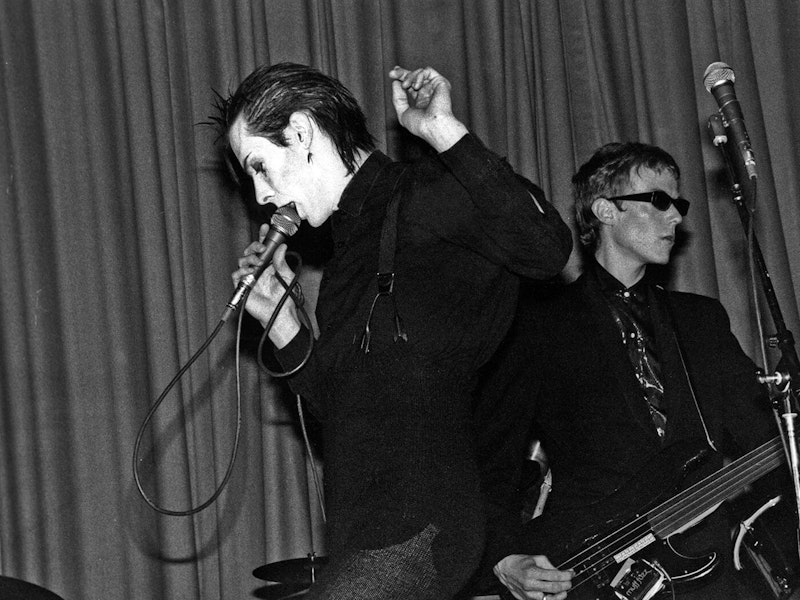On August 16, 1956, Bela Lugosi laid down to take a nap in his Los Angeles apartment. Lugosi was a Hungarian actor known for playing Count Dracula and other horror film roles in a 50-year career. At 6:45 p.m., his wife Hope returned from work to discover Lugosi dead in bed. He was 73. The cause of death was a heart attack.
Two decades later, a 20-year-old bass player named David John Haskins (aka David J) and his friend guitarist Daniel Ash were bingeing on late-night vampire movies in Northampton, England. The two recently joined a band called Bauhaus. They told their other two bandmates, drummer Kevin Haskins and singer Peter Murphy, that it’d be cool to write a song about vampires.
While biking home from his job at a warehouse packing boxes of lard, David J was inspired by a song idea. He wrote lyrics on colored shipping labels from his job. “I came up with that first line, ‘White on white, translucent, black capes back on the rack.’ And it was like, ‘Oh, this is interesting.’ It’s so descriptive—it’s about the vampire. It’s also about the actor—it’s about retiring from the part, but… a vampire can never retire from being a vampire, because that’s for eternity.’”
David J brought the lyrics to band rehearsal. Lead singer Peter Murphy came up with a vocal melody and the band improvised instrumental parts. Daniel Ash’s moody guitar riff was inspired by an old Gary Glitter song (“Rock and Roll”). Kevin Haskins, who was just learning drums, played a ticking bossa nova beat. David J’s pulsing bassline was a funky dub reggae rhythm. Three minutes into the song, Murphy makes his vocal entrance with a bleak and gloomy baritone.
The song is theatrical with brooding and hypnotic vocal effects and atmospheric tones like a haunting dirge. The lyrics depict Lugosi’s funeral with swooping bats and “virginal brides” marching past his coffin. The corpse is “left alone in a darkened room” as Murphy sings “Bela Lugosi’s dead” only to learn he’s actually “undead, undead, undead.”
Six weeks later, the four musicians met at Beck Studios in Wellingborough for their first recording session. 21-year-old Murphy had never recorded into a studio microphone before. He also had a cold. The session lasted six hours and the resulting 9-1/2 minute song was captured in a single take. The band had no way of knowing they were about to inspire a new music genre called Goth.
Relying on heavy bassline, ethereal guitar and haunting vocals, goth music took over England. New bands appeared like Siouxsie and the Banshees, The Cure, Sisters of Mercy and Killing Joke. Goth clubs popped up in every major city as did a new fashion sense focusing on black garb, black lipstick and black eyeliner.
‘“Bela Lugosi’s Dead” became the ‘Stairway To Heaven’ of the 1980s,” Murphy said. But it wasn’t an easy sell at first. Virgin, EMI and Beggars Banquet all rejected the song. They said it wasn’t commercial and should be edited down to three minutes. It took a year until the song was released as a 12-inch single by Small Wonder Records in August 1979.
The song was too long for mainstream radio but became a staple of indie radio. John Peel invited Bauhaus to record a Peel Session on BBC Radio 1. Listeners jammed BBC switchboards asking them to play the song again. Bauhaus signed with 4AD Records who released their debut album In The Flat Field. NME described the record as “Gothick-Romantick pseudo-decadence.” Bauhaus moved to the larger parent company, Beggars Banquet.
After the song appeared in the opening sequence of the 1983 erotic vampire film The Hunger starring David Bowie, Bauhaus gained a mainstream audience. They didn’t immediately embrace the goth ethos preferring the term “dark glam.” “It’s funny, because I sometimes say we weren’t goth,” said Daniel Ash. “That term was a bit of an insult in England back then. We were lumped in with Alien Sex Fiend, Sex Gang Children and Specimen, who we all thought were really crap.”
“The song has a timeless quality,” said drummer Kevin Haskins. “I marvel at what we did. We were just four young kids who wanted to make something unique, without having much idea what we were doing. But that song came out of it.”
Bauhaus toured between 1981–83 and released three albums. Before recording their fourth album Burning From the Inside, Murphy contracted pneumonia. The band made the album without him, creating a rift. Bauhaus broke up in 1983 playing their final show at the Hammersmith Palais in London. They reunited in 1998 for a tour then broke up again before releasing a final album in 2008. Band members went on to form Tones on Tail and Love and Rockets while Murphy formed Dali’s Car then moved on to a successful solo career.
Rolling Stone ranked “Bela Lugosi’s Dead” as #60 in their “100 Greatest Debut Singles of All Time.” The Guardian rated the song #19 on the 50 key events in indie music history. Nine Inch Nails, Massive Attack and Nouvelle Vague all covered the song. Saturday Night Live used the song for their skit “Goth Talk” while Bauhaus was parodied on Beavis and Butthead and South Park.

